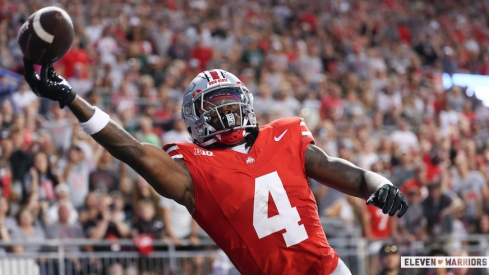Caleb Downs wins the Jim Thorpe Award, but Jeremiah Smith gets snubbed from the Biletnikoff Award.

One of the more interesting offenses to watch this fall will be the Cal Bears offense under new head coach Sonny Dykes and his offensive coordinator Tony Franklin. The duo comes to Berkeley via Louisiana Tech, where they led one of college football's most prolific offenses. In 2012, Louisiana Tech was number 1 in total offense, scoring offense, red zone efficiency and number 3 in 'explosive plays.'*
Ohio State must square off against Dykes and Franklin in the 2013 season's first month. While the Bears may not have the talent to match up with the Buckeyes, the OSU defense will nonetheless face a schematic challenge.
The Airraid Evolution
Dykes and Franklin are practitioners of the 'Airraid' offense--the pass-first offense developed by Hall Mumme and Mike Leach at not-exactly football hotspots like Iowa Wesleyan and Valdosta State that is now one of the more common systems in major college football. The Airraid's rise has been oft-discussed, but its backbone is relatively straightforward.
Mumme and Leach pass concepts come from Sid Gillman, whose system is the underpinning of all modern passing offenses. Gilman packaged routes together as concepts that are purposefully designed to attack coverages, namely by using 'stretches' that put more receivers in an area of a zone then there are defenders, or patterns that run away from man coverage. In the late 1980s Mumme and Leach made pilgrimages to BYU, where Lavell Edwards and Norm Chow were having success with this NFL-style passing offense in college. In this way the Air Raid is but one variation of the orthodox modern offense.
As Chris Brown discusses, Mumme and Leach took BYU's system and adapted it to make it their own. The duo's goal was to make the offense even more pass friendly. They put their quarterback in the shotgun and widened their offensive linemen's splits to force defenders to take wider pass rushing routes. The pair wanted to spread everyone out and throw timing routes in space. Leach's favorite pass play is 'mesh,' which is just a shallow crossing route from each side.
Mumme's and Leach's key insight, though, was not the individual plays but the overall method. They made the system simple and flexible enough that it could be learned and executed by small college and high school athletes. The duo purposefully eschewed complexity. Mumme and Leach correctly understood that with limited practice time specialization would increase their players' execution. It may seem tautological but being so pass-oriented allowed them to focus upon passing in practice. Mumme and Leach's teams generally only used one or two run plays, instead running repetitions for a dozen pass plays over and over. They also kept their receivers in the same position to the left or right side. That way the receivers only had to learn routes from one position. The Airraid's offense could be installed in three practices. Once the installation was complete, players could spend countless hours running the same routes and mastering the nuances of their position.
The Air Raid also made it possible to excel with overlooked quarterbacks with weak arms but quick decision-making. Plays such as mesh utilize short throws that unfold right before the quarterback. Leach was able to ride this theory to a national championship as offensive coordinator at Oklahoma with junior college transfer Josh Heupel (himself now a coach). Part of the Airraid's appeal has been the relative ease of implementation.
Philosophy in Motion
As the Air Raid has gained in popularity, the coaches from Leach and Mumme's coaching tree have altered their own philosophies. The primary change, perhaps best epitomized by Dana Holgorsen, is an increased use of vertical stem routes (routes where the wide receivers initially run downfield so that defenders cannot pattern read) and more power running. But the philosophic approach remains.
So too it is for Dykes, a Leach assistant, and Franklin, the 'Johnny Appleseed' of the Airraid who created the 'System' that could be implemented by High School coaches. Dykes and Franklin have thrived by making their offense even more streamlined. The pair have eschewed mesh and other crossing routes. They instead run quick wide receiver screens and perimeter out and vertical routes routes combined with inside zone and power.
Dykes and Franklin do this for one reason--speed. Franklin's goal is to be the fastest team running plays in America. To go fast, the duo uses a unique system. They run the offense through the center--not the quarterback. The center gets the plays from the sideline, reads the defense, calls the blocking assignments and then announces the snap count.
Dykes and Franklin believe that an offense playing fast is another way to deceive the defense. Defenders do not have time to analyze tendencies or fully adjust. The speed works in tandem with the combination of outside passing game and inside running game. It horizontally stretches the defense, forcing them to cover the entire field. The theory is that by forcing the defense to play quickly and cover the whole field, eventually they will break.
The philosophy has an additional benefit in practice repetitions. Just as Leach and Mumme sought to cure down the playbook to allow players to get additional reps in their base plays, Dykes and Franklin's up-tempo framework allows the team to cycle through extensive repetitions, allowing for fast, physical practices.
All In
Judging from Cal spring practice reports, Dykes and Franklin have further built upon this philosophy. Every play Cal runs is a 'packaged play,' that being a play that contains both a run and pass option. The quarterback can choose which to utilize, depending upon how the defense reacts. Packaging plays prevents a defense from guessing correctly with Dykes and Franklin's horizontal stretches. If a backside defender, for example, overplays a zone run, the quarterback will simply pull the ball and make a quick throw to the defender's vacated spot. The duo will package inside run plays with a perimeter pass play. This goes beyond combining a zone run play with a wide receiver screen to using backside route combinations. For instance, Franklin will combine a backside stick route with stretch.

As Brophy writes, combining a run with a pass concept is nothing new, but here we see Franklin running 3x1 to the field, expecting to get the split boundary receiver manned-up by the corner. He combines Stick to counter balance stretch, eliminating even more defenders from the equation than typical in defender-read attacks.
The defense has to respect the 3-man surface to the field, so the 3-on-2 defensive advantage (C,S,N) on the X & H is lost when Y is introduced. Now a box player has to be aware of how he will have to help on the first inside receiver. In essence, not only are you going to put the read-defender (overhang / nickel) in conflict with a horizontal stretch, you’re also going to influence backside run-support gap integrity by attacking the box player (WLB).
It comes together beautifully when also eliminate a defender from the equation simply by space. The backside defensive end will be left untouched on a boundary stretch run and since the throw (backside) is so wide, he will not be a factor in stopping the pass (or reaching the passer because he will have to respect run action mesh taking place in front of him.
Now it becomes an attack on the WLB, the 6th box player. He can either fit in run support to stop the BIG runs of stretch, or he can help close the field-side chasm created when H & Y stretch the overhang defender with a Stick/Out. The WLB cannot do both.
Every play for Cal will have some type of package that allows the offense to punish a defense that is out-of-position, similar to a triple option team.
Dykes and Franklin's system is easy for his players to learn but puts extraordinary pressure on a defense through its speed and ability to get easy yards in space. The Buckeye defense will have to adequately handle the Cal Bears' tempo, remain disciplined in their responsibilities and tackle in space. Dykes and Franklin will thus pose an interesting easy season schematic challenge.
* Brophy's Blogspot has provided fantastic coverage of Dykes and Franklin's time at Louisiana Tech. Much of this article is drawn from their analysis. For all of Brophy's articles addressing Louisiana Tech, see here.

